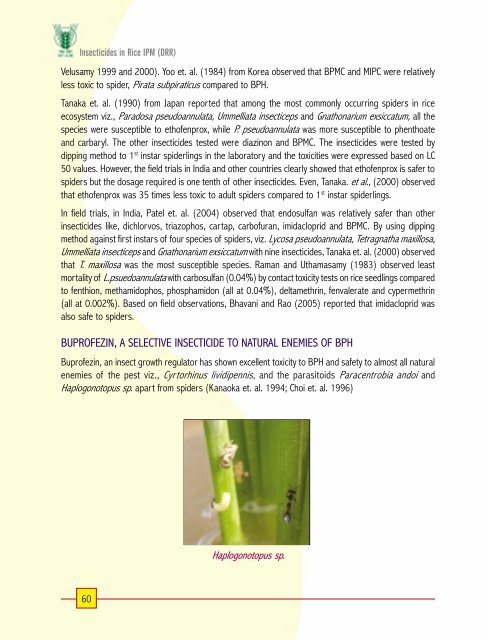priciples of insecticide use in rice ipm
priciples of insecticide use in rice ipm
priciples of insecticide use in rice ipm
Create successful ePaper yourself
Turn your PDF publications into a flip-book with our unique Google optimized e-Paper software.
Insecticides <strong>in</strong> Rice IPM (DRR)<br />
Velusamy 1999 and 2000). Yoo et. al. (1984) from Korea observed that BPMC and MIPC were relatively<br />
less toxic to spider, Pirata subpiraticus compared to BPH.<br />
Tanaka et. al. (1990) from Japan reported that among the most commonly occurr<strong>in</strong>g spiders <strong>in</strong> <strong>rice</strong><br />
ecosystem viz., Paradosa pseudoannulata, Ummelliata <strong>in</strong>secticeps and Gnathonarium exsiccatum, all the<br />
species were susceptible to eth<strong>of</strong>enprox, while P. pseudoannulata was more susceptible to phenthoate<br />
and carbaryl. The other <strong><strong>in</strong>secticide</strong>s tested were diaz<strong>in</strong>on and BPMC. The <strong><strong>in</strong>secticide</strong>s were tested by<br />
dipp<strong>in</strong>g method to 1st <strong>in</strong>star spiderl<strong>in</strong>gs <strong>in</strong> the laboratory and the toxicities were expressed based on LC<br />
50 values. However, the field trials <strong>in</strong> India and other countries clearly showed that eth<strong>of</strong>enprox is safer to<br />
spiders but the dosage required is one tenth <strong>of</strong> other <strong><strong>in</strong>secticide</strong>s. Even, Tanaka. et al., (2000) observed<br />
that eth<strong>of</strong>enprox was 35 times less toxic to adult spiders compared to 1st <strong>in</strong>star spiderl<strong>in</strong>gs.<br />
In field trials, <strong>in</strong> India, Patel et. al. (2004) observed that endosulfan was relatively safer than other<br />
<strong><strong>in</strong>secticide</strong>s like, dichlorvos, triazophos, cartap, carb<strong>of</strong>uran, imidacloprid and BPMC. By us<strong>in</strong>g dipp<strong>in</strong>g<br />
method aga<strong>in</strong>st first <strong>in</strong>stars <strong>of</strong> four species <strong>of</strong> spiders, viz. Lycosa pseudoannulata, Tetragnatha maxillosa,<br />
Ummelliata <strong>in</strong>secticeps and Gnathonarium exsiccatum with n<strong>in</strong>e <strong><strong>in</strong>secticide</strong>s, Tanaka et. al. (2000) observed<br />
that T. maxillosa was the most susceptible species. Raman and Uthamasamy (1983) observed least<br />
mortality <strong>of</strong> L.psuedoannulata with carbosulfan (0.04%) by contact toxicity tests on <strong>rice</strong> seedl<strong>in</strong>gs compared<br />
to fenthion, methamidophos, phosphamidon (all at 0.04%), deltamethr<strong>in</strong>, fenvalerate and cypermethr<strong>in</strong><br />
(all at 0.002%). Based on field observations, Bhavani and Rao (2005) reported that imidacloprid was<br />
also safe to spiders.<br />
BUPROFEZIN, A SELECTIVE INSECTICIDE TO NATURAL ENEMIES OF BPH<br />
Bupr<strong>of</strong>ez<strong>in</strong>, an <strong>in</strong>sect growth regulator has shown excellent toxicity to BPH and safety to almost all natural<br />
enemies <strong>of</strong> the pest viz., Cyrtorh<strong>in</strong>us lividipennis, and the parasitoids Paracentrobia andoi and<br />
Haplogonotopus sp. apart from spiders (Kanaoka et. al. 1994; Choi et. al. 1996)<br />
60<br />
Haplogonotopus sp.











